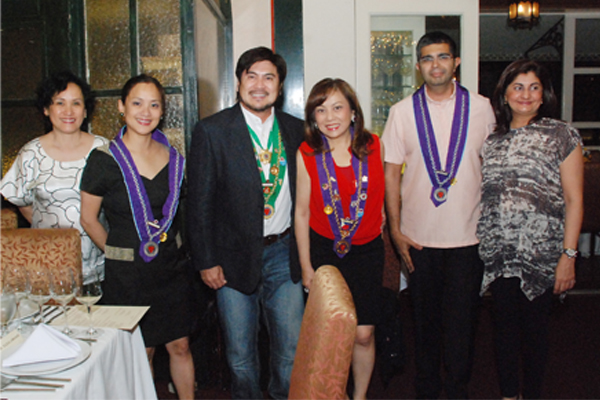

A unique wine tasting event was celebrated by the L’Ordre Mondial Des Gourmet Degustateurs last 19 April 2012 at the Café Ysabel Restaurant in San Juan, Metro Manila. Dubbed as “Sumsuman” - a Pampangeño reference to the pairing of wine and food - the carefully selected wines for the occasion were matched with a variety of Filipino dishes crafted by the talented team of Chef Gene Gonzalez.

The members and guests of the Chaine and Ordre Mondial were charmingly enveloped in the turn-of-the-century Manila backdrop of the dining hall. Illumination came from Echanson Arnie del Rosario and Professional du vin Jay Labrador, as they led the wine tasting through the (no less than) nineteen dishes served that evening.
The dinner started with Galantina con Venagueta de Trufas, a refreshing take on the Chicken Galantina as it featured chorizo for added depth of flavor without encroaching on the delicate nature of the white meat. This was immediately followed by Sinigang na Ulang, Sulipan Style, a soup soured by lemongrass and kamias that highlighted the enormous Ulang (or freshwater prawn) the size of one’s hand and with antennae extending far beyond the plate holding it. Both dishes were introduced by glasses of the familiarly crisp and citrusy Cava from the cellars of Pere Ventura.
Next came an onslaught of heated and spicy flavors of the creamy Laing. Loose taro leaves cooked in coconut cream accompanied by Putong Calasiao and a surprisingly delicately-flavored Pancit Luglug. The latter a rice noodle dish of the Tagalog region dressed in a shrimp and kasubha sauce with crunchy chicharon and tuyo flakes. Also present was the Kare-Kareng Apalit or the Apalit-style oxtail stew oozing in rich peanut sauce served with a side of the sweet-saltiness of sautéed shrimp paste which cut through the dish’s silky texture. These dishes were matched by the equally clean and fruity taste of the Villa Wolf Gewurtztraminer2009 Pfalz, the wine’s delicate aroma of spice and fresh roses (with just a hint of lychee and fresh acidity) make it a perfect accompaniment to Filipino dishes.
There was a graduation to the more complex flavors of the Bicol Express, a fiery dish from sliced finger chilies and minced pork tempered by coconut cream and made aromatic from its wrapping of banana leaves. This was closely followed by Buro sa Mustasa, a DIY entrée where fermented shrimp is wrapped and rolled in fresh mustard leaves. Then a tweak on the Adobong Pusit (Squid Ink Adobo), served as soup with rice vermicelli noodles. Then the Pinakbet, vegetable stew of okra, squash, bitter gourd, eggplant, and stringbeans. A glass or two of a textured white wine such as the WitherHills Pinot Gris 2011 from the vineyards of Marlborough, New Zealand was just the ticket, as its noticeable heady floral aroma offset the saltiness of the dishes, its ripe peach and pear flavors giving a lingering finish to the mouth. In essence, a slightly more aggressive persona of the Gewurtztraminer to equal the adventurous flavors of the three plates just served.

After an intermission of a refreshing sorbet from unfermented coconut sap, a celebratory Filipino dinner will not be complete without adobo and lechon. Chef Gonzalez graced the table with a chicken and pork Adobo del Diablo, a version that is twice-cooked (stewed and baked). With equal billing and honor on the table was the Lechon Balamban (or roasted pork belly), with skin that stayed smooth, glistening and crunchy. These heart friendly dishes were paired with the equally accessible Laurus Cote De Rhone Village 2010, a medium-bodied cousin of Syrah, subtle and sensual, yet worldly wise enough not to upstage the adobo and lechon. The wine’s complexity and depth makes it a perfect “sauce” in a glass to the dry meat dishes.
As if that was not enough, another train of meat dishes came, led by the garlicky crunch of Longganisang Lucban (small sausages Lucban, Quezon style), followed by the tenderly sauced Angus Bistek Tagalog, and trailed by the true velvet of Kalderetang Kambing (or goat meat stew) slow-cooked in tomato sauce with root vegetables and olives. These soul-food dishes were engaged by the old-school tempranillo variety in glasses of Resalte Ribera de Duero Crianza 2005. Its toasty oak and vanilla tones, berry notes, and long lingering finish made it a real treat for the variety of flavors of the different meat dishes.
Sighs of appreciation all around the room came when guests were served with a dessert buffet on a plate, presented as a salute to the Filipino dining custom of “patikim” (taste-testing). The Turon Baduya (fried banana wrapped in rice paper and sweetened with jackfruit), Ube Haleya (taro root pudding), Brazo de Mercedez (meringue roll with egg custard center), and Tableya (chocolate tablet) ice cream were highlighted by the creamy and full-bodied sherry Nectar Pedro Ximenez Gonzalez Byass. The elixir gave off chocolate shop aromas and tastes of caramel, nuts and prunes coating the mouth with intense sweet flavors.
As the guests went off happily home into the soft, warm Manila air, everyone’s smile confirmed the erasure of any doubt that Filipino dishes – be it paired with beer, whisky, or wine – are the stuff that any gourmet’s dreams should be made of.